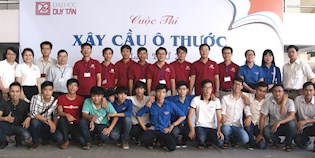Tài liệu học tập
1 A rectangular tank is 1.0 m long and 0.7 m wide and contains fresh water to a depth of 0.5 m. (a) What is the gauge pressure at the bottom of the tank in N/m ? (b) What is the absolute pressure at the bottom of the tank?
[4905 N/m2; 105 905 N/m2]
2 For the tank in question 1, using gauge pressure, calculate (a) the mean pressure intensity on the 0.7m wide end of the tank; (b) the mean pressure intensity on the 1.0m long side of the tank; (c) the force on the end of the tank; and (d) the force on the side.
[2453 N/m2; 2453 N/m2; 858 N; 1226 N]
3 A dam that retains fresh water has a vertical face. Over a one metre length of the face at the centre of the valley the water has a depth of 38 m. (a) Calculate the resultant force on this unit length of the face. (b) At what depth from the surface does the resultant force act?
[7083 ¥ 103N; 25.33 m]
4 A gate at the end of a sewer measures 0.8 m by 1.2 m wide. It is hinged along its top edge and hangs at an angle of 30° to the vertical, this being the angle of the banks of a trapezoidal river channel. (a) Calculate the hydrostatic force on the gate and the vertical distance between the centroid of the gate, G, and the centre of pressure, P, when the river level is 0.1 m above the top of the hinge. (b) If the river level increases to 2.0 m above the hinge, what is the force and the distance GP now? (c) Has the value of GP increased or decreased, and why has it changed in this manner?
[(a) 4.21 ¥ 103 N, 0.090 m; (b) 22.10 ¥ 103 N, 0.017 m]
5 A circular gate of 0.5 m radius is hinged so that it rotates about its horizontal diameter, that is it rotates about a horizontal line passing through the centroid of the gate. The gate is at the end of a pipe discharging to a river. Measured above the centroid of the gate, the head in the pipe is 6.0 m while the head in the river is 2.0 m. Assuming that the gate is initially vertical: (a) calculate the force
exerted by the water in the pipe on the gate, and the distance GP between the centre of the gate, G, and the centre of pressure, P; (b) calculate the force exerted by the river water on the gate, and the distance GP; (c) by taking moments about the hinge, using the results from above, determine the net turning moment on the gate caused by the two forces acting at their respective centres of pressure on opposite sides of the gate. Explain your answer.
[(a) 46 228.5 N at 0.0104 m; (b) 15 409.5 N at 0.0312 m; (c) 0 exactly, allowing for rounding errors]
Bài viết liên quan





